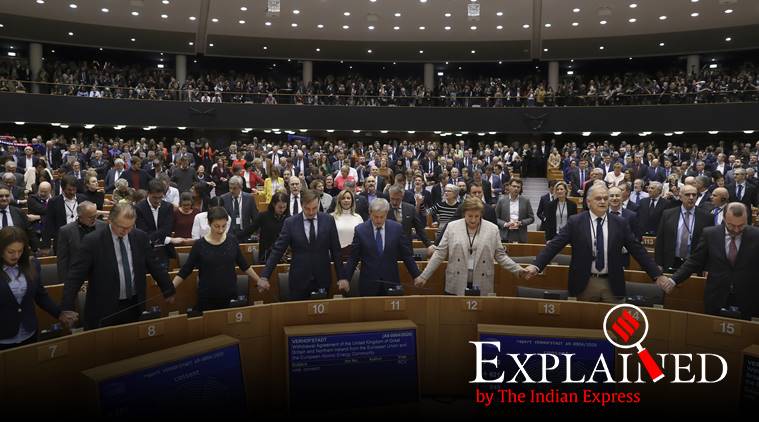Explained: European Parliament approves Brexit deal; what next?
The European Parliament vote marked the final stage in the ratification process of Brexit, or Britain's exit from the EU, a process that has been going on for more than three years.
 MEP’s sing and hold hands after a vote on the UK’s withdrawal from the EU, the final legislative step in the Brexit proceedings, during the plenary session at the European Parliament in Brussels, Wednesday, Jan. 29, 2020. (Photo via AP)
MEP’s sing and hold hands after a vote on the UK’s withdrawal from the EU, the final legislative step in the Brexit proceedings, during the plenary session at the European Parliament in Brussels, Wednesday, Jan. 29, 2020. (Photo via AP)
The European Parliament Thursday approved the terms for the UK’s departure from the European Union. There were 621 votes for and 49 against the Brexit Withdrawal Agreement deal, with 13 abstentions. This marked the final stage in the ratification process of Brexit, or Britain’s exit from the EU, a process that has been going on for more than three years.
When did the Brexit process start?
The first public vote on Brexit happened on June 23, 2016, when 52 per cent of voters chose to leave the EU. David Cameron, who was the prime minister at the time, had announced he will hold a referendum on the UK’s membership of the EU if his party won the 2013 general elections. After Cameron was voted in for a second term, the European Union Referendum Act, 2015 was passed and the referendum was held in June 2016.
Cameron resigned a day after the referendum since he supported UK staying in the EU. He was succeeded by Theresa May.
Brexit was meant to happen on March 29, 2019 two years after May had triggered Article 50, which officially signified the decision of the UK to leave the EU. These two years were given to May’s government to come up with a deal to leave the EU.
The March 29 deadline was delayed twice after MPs rejected the withdrawal deal negotiated by May with the EU.
This withdrawal deal was negotiated by May with the EU and was agreed upon in November 2018. After the MPs rejected the deal for the third time, May resigned and was succeeded by Boris Johnson. The central sticking point for the MPs were the Irish backstops, which determine the nature of the border between Northern Ireland (part of the UK) and the Republic of Ireland.
At present, people and goods can move freely between the two areas because both are part of the EU’s single market and customs union, but the border situation will change post-Brexit.
Having the backstops means there would be no border between Northern Ireland and the Republic of Ireland, something which was opposed by the Democratic Unionist Party (DUP) of Northern Ireland since they see the backstops as weakening Northern Ireland’s position within the UK.
Essentially, having backstops would mean Northern Ireland would follow the same rules as the Republic of Ireland and the EU. In fact, these backstops were one of the main reasons why May had to resign.
Now under Johnson, the backstops have been removed and instead his deal will lead to the creation of a barrier between Great Britain and Northern Ireland.
What is the significance of the European Parliament’s vote?
The Withdrawal Agreement Bill (WAB) became law on January 23, 2020 when it was passed all stages in Parliament and was given the Royal Assent. WAB gives the UK government provisions through which it can ratify the Brexit process.
According to BBC, Wednesday’s session was “largely symbolic” since it was “inevitable” that the deal would be endorsed by the Parliament, given its main committees have already given their approval. Therefore, the ratification by the European Parliament was simply a formal approval of a decision that was already known.
After the UK leaves the EU a 23.00 GMT on January 31, there will be an 11-month long transition period, during which the UK and EU will negotiate the nature of their post-Brexit economic relationship.
Until then the UK will remain in the EU’s single market and customs union and the movement of people between the UK and the rest of the EU will also continue.
- 01
- 02
- 03
- 04
- 05






































